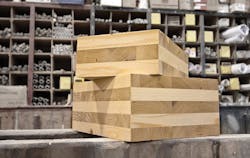Concrete Association builds case against cross-laminated timber
Build with Strength, a coalition of the National Ready Mixed Concrete Association (NRMCA), has embarked on a campaign expressing concern about the use of cross-laminated timber (CLT) in construction.
The coalition says that the nature of wood, which they say is prone to fire, termites, earthquakes, and humidity, makes it a questionable building material. “At the moment, sufficient testing has not taken place to verify the durability and strength of CLT,” the group said in a news release.
“Within the United States, cross-laminated timber is really a new material, a new process,” said Jon Narva, Director of External Relations for the National Association of State Fire Marshals. “We still don’t know a lot about it, we’re trying to understand better how to protect the public with those buildings coming into being. It’s certainly a fair statement to say we understand concrete and what it’s going to do under fire conditions better than we do cross-laminated timber.”
Last year, the coalition says, Washington State experienced the largest wildfire in its history, when 175 homes were destroyed and more than a million acres burned. Should such an event happen again, the best bet would be to make sure one’s residence is built with the most resilient material available: concrete. Advocates for increased use of CLT have touted its strength and sustainability, with some designers beginning to use the material for high-rise buildings.
